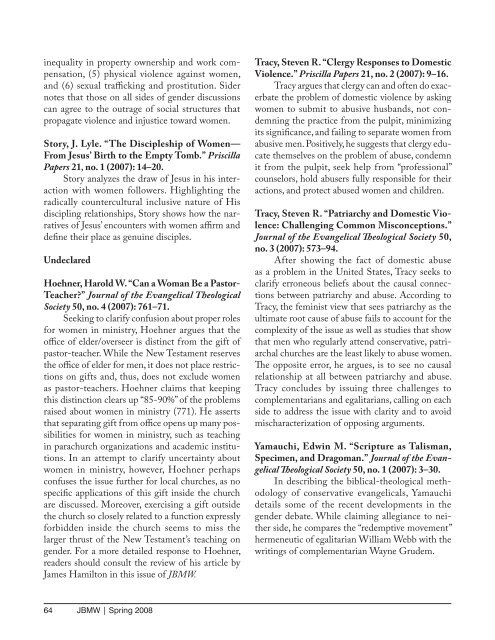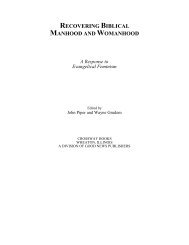Download PDF - The Council on Biblical Manhood and Womanhood
Download PDF - The Council on Biblical Manhood and Womanhood
Download PDF - The Council on Biblical Manhood and Womanhood
Create successful ePaper yourself
Turn your PDF publications into a flip-book with our unique Google optimized e-Paper software.
inequality in property ownership <strong>and</strong> work compensati<strong>on</strong>,(5) physical violence against women,<strong>and</strong> (6) sexual trafficking <strong>and</strong> prostituti<strong>on</strong>. Sidernotes that those <strong>on</strong> all sides of gender discussi<strong>on</strong>scan agree to the outrage of social structures thatpropagate violence <strong>and</strong> injustice toward women.Story, J. Lyle. “<str<strong>on</strong>g>The</str<strong>on</strong>g> Discipleship of Women—From Jesus’ Birth to the Empty Tomb.” PriscillaPapers 21, no. 1 (2007): 14–20.Story analyzes the draw of Jesus in his interacti<strong>on</strong>with women followers. Highlighting theradically countercultural inclusive nature of Hisdiscipling relati<strong>on</strong>ships, Story shows how the narrativesof Jesus’ encounters with women affirm <strong>and</strong>define their place as genuine disciples.UndeclaredHoehner, Harold W. “Can a Woman Be a Pastor-Teacher?” Journal of the Evangelical <str<strong>on</strong>g>The</str<strong>on</strong>g>ologicalSociety 50, no. 4 (2007): 761–71.Seeking to clarify c<strong>on</strong>fusi<strong>on</strong> about proper rolesfor women in ministry, Hoehner argues that theoffice of elder/overseer is distinct from the gift ofpastor-teacher. While the New Testament reservesthe office of elder for men, it does not place restricti<strong>on</strong>s<strong>on</strong> gifts <strong>and</strong>, thus, does not exclude womenas pastor-teachers. Hoehner claims that keepingthis distincti<strong>on</strong> clears up “85-90%” of the problemsraised about women in ministry (771). He assertsthat separating gift from office opens up many possibilitiesfor women in ministry, such as teachingin parachurch organizati<strong>on</strong>s <strong>and</strong> academic instituti<strong>on</strong>s.In an attempt to clarify uncertainty aboutwomen in ministry, however, Hoehner perhapsc<strong>on</strong>fuses the issue further for local churches, as nospecific applicati<strong>on</strong>s of this gift inside the churchare discussed. Moreover, exercising a gift outsidethe church so closely related to a functi<strong>on</strong> expresslyforbidden inside the church seems to miss thelarger thrust of the New Testament’s teaching <strong>on</strong>gender. For a more detailed resp<strong>on</strong>se to Hoehner,readers should c<strong>on</strong>sult the review of his article byJames Hamilt<strong>on</strong> in this issue of JBMW.Tracy, Steven R. “Clergy Resp<strong>on</strong>ses to DomesticViolence.” Priscilla Papers 21, no. 2 (2007): 9–16.Tracy argues that clergy can <strong>and</strong> often do exacerbatethe problem of domestic violence by askingwomen to submit to abusive husb<strong>and</strong>s, not c<strong>on</strong>demningthe practice from the pulpit, minimizingits significance, <strong>and</strong> failing to separate women fromabusive men. Positively, he suggests that clergy educatethemselves <strong>on</strong> the problem of abuse, c<strong>on</strong>demnit from the pulpit, seek help from “professi<strong>on</strong>al”counselors, hold abusers fully resp<strong>on</strong>sible for theiracti<strong>on</strong>s, <strong>and</strong> protect abused women <strong>and</strong> children.Tracy, Steven R. “Patriarchy <strong>and</strong> Domestic Violence:Challenging Comm<strong>on</strong> Misc<strong>on</strong>cepti<strong>on</strong>s.”Journal of the Evangelical <str<strong>on</strong>g>The</str<strong>on</strong>g>ological Society 50,no. 3 (2007): 573–94.After showing the fact of domestic abuseas a problem in the United States, Tracy seeks toclarify err<strong>on</strong>eous beliefs about the causal c<strong>on</strong>necti<strong>on</strong>sbetween patriarchy <strong>and</strong> abuse. According toTracy, the feminist view that sees patriarchy as theultimate root cause of abuse fails to account for thecomplexity of the issue as well as studies that showthat men who regularly attend c<strong>on</strong>servative, patriarchalchurches are the least likely to abuse women.<str<strong>on</strong>g>The</str<strong>on</strong>g> opposite error, he argues, is to see no causalrelati<strong>on</strong>ship at all between patriarchy <strong>and</strong> abuse.Tracy c<strong>on</strong>cludes by issuing three challenges tocomplementarians <strong>and</strong> egalitarians, calling <strong>on</strong> eachside to address the issue with clarity <strong>and</strong> to avoidmischaracterizati<strong>on</strong> of opposing arguments.Yamauchi, Edwin M. “Scripture as Talisman,Specimen, <strong>and</strong> Dragoman.” Journal of the Evangelical<str<strong>on</strong>g>The</str<strong>on</strong>g>ological Society 50, no. 1 (2007): 3–30.In describing the biblical-theological methodologyof c<strong>on</strong>servative evangelicals, Yamauchidetails some of the recent developments in thegender debate. While claiming allegiance to neitherside, he compares the “redemptive movement”hermeneutic of egalitarian William Webb with thewritings of complementarian Wayne Grudem.64 JBMW | Spring 2008




